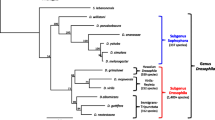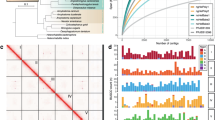Abstract
Vertebrate immune system molecules that bind directly to parasites are commonly subject to strong directional natural selection, probably because they are engaged in an evolutionary arms race with parasites. We have investigated whether similar patterns of evolution are seen in components of the Drosophila immune system that bind parasite-derived molecules. In insects, TEPs (thioester-containing proteins) function as opsonins, binding to parasites and promoting their phagocytosis or encapsulation. The Drosophila melanogaster genome encodes four TEPs, three of which are upregulated after an immune challenge. We report that two of these three Drosophila genes evolve rapidly under positive selection and that, in both TepI and TepII, the “bait-like region” (also known as the variable region) shows the strongest signature of positive selection. This region may be the site of proteolytic cleavage that leads to the activation of the molecule. It is possible that the proteolytic activation of TEPs is a target of host-parasite coevolution, with parasites evolving to prevent proteolysis, which in turn favors mutations in the bait-like region that restore the response. We also sequenced three gram-negative binding proteins (GNBPs) and two immune-induced peptides with strong homology to the GNBPs. In contrast to the Tep genes, the GNBP genes are highly conserved. We discuss the reasons why different components of the immune system have such different patterns of evolution.


Similar content being viewed by others
References
Altschul SF, Madden TL, Schaffer AA, Zhang JH, Zhang Z, Miller W, Lipman DJ (1997) Gapped BLAST and PSI-BLAST: a new generation of protein database search programs. Nucleic Acids Res 25:3389–3402
Andolfatto P (2001) Contrasting patterns of X-linked and autosomal nucleotide variation in Drosophila melanogaster and Drosophila simulans. Mol Biol Evol 18:279–290
Andolfatto P, Przeworski M (2000) A genome-wide departure from the standard neutral model in natural populations of Drosophila. Genetics 156:257–268
Barrett JA (1988) Frequency-dependent selection in plant fungal interactions. Philos Trans Roy Soc Lond Ser B Biol Sci 319:473–483
Begun DJ, Aquadro CF (1992) Levels of naturally occurring DNA polymorphism correlate with recombination rates in D. melanogaster. Nature 356:519–520
Begun DJ, Whitley P (2000) Adaptive evolution of Relish, a Drosophila NF-{κ}B/I{κ}B protein. Genetics 154:1231–1238
Bendtsen JD, Nielsen H, von Heijne G, Brunak S (2004) Improved prediction of signal peptides: SignalP 3.0. J Mol Biol 340:783–795
Blandin S, Levashina EA (2004) Thioester-containing proteins and insect immunity. Mol Immunol 40:903–908
Blandin S, Shiao SH, Moita LF, Janse CJ, Waters AP, Kafatos FC, Levashina EA (2004) Complement-like protein TEP1 is a determinant of vectorial capacity in the malaria vector Anopheles gambiae. Cell 116:661–670
Bulmer MS, Crozier RH (2004) Duplication and diversifying selection among termite antifungal peptides. Mol Biol Evol 21:2256–2264
Bulmer MS, Crozier RH (2005) Variation in positive selection in termite GNBPs and Relish. Mol Biol Evol 23:317–326
Christophides GK, Zdobnov E, Barillas-Mury C, Birney E, Blandin S, Blass C, Brey PT, Collins FH, Danielli A, Dimopoulos G, Hetru C, Hoa N, Hoffmann JA, Kanzok SM, Letunic I, Levashina EA, Loukeris TG, Lycett G, Meister S, Michel K, Muller HM, Osta MA, Paskewitz SM, Reichhart JM, Rzhetsky A, Troxler L, Vernick KD, Vlachou D, Volz J, von Mering C, Xu JN, Zheng LB, Bork P, Kafatos FC (2002) Immunity-related genes and gene families in Anopheles gambiae. Science 298:159–165
Clark AG, Wang L (1997) Molecular population genetics of Drosophila immune system genes. Genetics 147:713–724
Comeron JM (1995) A method for estimating the numbers of synonymous and nonsynonymous substitutions per site. J Mol Evol 1:1152–1159
David JR, Capy P (1988) Genetic variation of Drosophila melanogaster natural populations. Trends Genet 4:106–111
De Gregorio E, Spellman PT, Rubin GM, Lemaitre B (2001) Genome-wide analysis of the Drosophila immune response by using oligonucleotide microarrays. Proc Natl Acad Scie USA 98:12590–12595
Dimopoulos G, Richman A, Muller HM, Kafatos FC (1997) Molecular immune responses of the mosquito Anopheles gambiae to bacteria and malaria parasites. Proc Natl Acad Sci USA 94:11508–11513
Fabrick JA, Baker JE, Kanost MR (2004) Innate immunity in a pyralid moth—functional evaluation of domains from a beta-1,3-glucan recognition protein. J Biol Chem 279:26605–26611
Fay JC, Wu CI (2000) Hitchhiking under positive Darwinian selection. Genetics 155:1405–1413
Ferrandon D, Imler J-L, Hoffmann JA (2004) Sensing infection in Drosophila: Toll and beyond. Semin Immunol 16:43
Gobert V, Gottar M, Matskevich AA, Rutschmann S, Royet J, Belvin M, Hoffmann JA, Ferrandon D (2003) Dual activation of the Drosophila Toll pathway by two pattern recognition receptors. Science 302:2126–2130
Hey J, Kliman RM (2002) Interactions between natural selection, recombination and gene density in the genes of Drosophila. Genetics 160:595–608
Hughes AL, Nei M (1988) Pattern of nucleotide substitution at major histocompatibility complex class-I loci reveals overdominant selection. Nature 335:167–170
Irving P, Troxler L, Heuer TS, Belvin M, Kopczynski C, Reichhart JM, Hoffmann JA, Hetru C (2001) A genome-wide analysis of immune responses in Drosophila. Proc Natl Acad Sci USA 98:15119–15124
Jiggins FM, Hurst GDD (2003) The evolution of parasite recognition genes in the innate immune system: purifying selection on Drosophila melanogaster peptidoglycan recognition proteins. J Mol Evol 57:598–605
Jiggins FM, Kim K-W (2005) The evolution of antifungal peptides in Drosophila. Genetics 171:1847–1859
Kim Y-S, Ryu J-H, Han S-J, Choi K-H, Nam K-B, Jang I-H, Lemaitre B, Brey PT, Lee W-J (2000) Gram-negative Bacteria-binding protein, a pattern recognition receptor for lipopolysaccharide and beta -1,3-glucan that mediates the signaling for the induction of innate immune genes in Drosophila melanogaster Cells. J Biol Chem 275:32721–32727
Ko WY, David RM, Akashi H (2003) Molecular phylogeny of the Drosophila melanogaster species subgroup. J Mol Evol 57:562–573
Krieger M, Acton S, Ashkenas J, Pearson A, Penman M, Resnick D (1993) Molecular flypaper, host defense, and atherosclerosis. Structure, binding properties, and functions of macrophage scavenger receptors. J Biol Chem 268:4569–4572
Lachaise D, Cariou ML, David JR, Lemeunier F, Tsacas L, Ashburner M (1988) Historical biogeography of the Drosophila melanogaster species subgroup. Evol Biol 22:159–225
Lagueux M, Perrodou E, Levashina EA, Capovilla M, Hoffmann JA (2000) Constitutive expression of a complement-like protein in Toll and JAK gain-of-function mutants of Drosophila. Proc Natl Acad Sci USA 97:11427–11432
Lazzaro BP (2005) Elevated polymorphism and divergence in the class C scavenger receptors of Drosophila melanogaster and D. simulans. Genetics 169:2023–2034
Lazzaro BP, Clark AG (2003) Molecular population genetics of inducible antibacterial peptide genes in Drosophila melanogaster. Mol Biol Evol 20:914–923
Leclerc V, Reichhart JM (2004) The immune response of Drosophila melanogaster. Immunol Rev 198:59–71
Lee W-J, Lee J-D, Kravchenko VV, Ulevitch RJ, Brey PT (1996) Purification and molecular cloning of an inducible Gram-negative bacteria-binding protein from the silkworm, Bombyx mori. Proc Natl Acad Sci USA 93:7888–7893
Levashina EA, Moita LF, Blandin S, Vriend G, Lagueux M, Kafatos FC (2001) Conserved role of a complement-like protein in phagocytosis revealed by dsRNA knockout in cultured cells of the mosquito, Anopheles gambiae. Cell 104:709
Little TJ, Colbourne JK, Crease TJ (2004) Molecular evolution of Daphnia immunity genes: polymorphism in a gram-negative binding protein gene and an alpha-2-macroglobulin gene. J Mol Evol 59:498–506
Marais G, Mouchiroud D, Duret L (2003) Neutral effect of recombination on base composition in Drosophila. Genet Res 81:79–87
McDonald JH (1996) Detecting non-neutral heterogeneity across a region of DNA sequence in the ratio of polymorphism to divergence. Mol Biol Evol 13:253–260
McDonald JH (1998) Improved tests for heterogeneity across a region of DNA sequence in the ratio of polymorphism to divergence. Mol Biol Evol 15:377–384
McDonald JH, Kreitman M (1991) Adaptive protein evolution at the Adh locus in Drosophila. Nature 351:652–654
Medzhitov R, Janeway CA (1997) Innate immunity: the virtues of a nonclonal system of recognition. Cell 91:295–298
Moriyama EN, Powell JR (1996) Intraspecific nuclear DNA variation in Drosophila. Mol Biol Evol 13:261–277
Nei M, Gojobori T (1986) Simple methods for estimating the numbers of synonymous and nonsynonymous nucleotide substitutions. Mol Biol Evol 3:418–426
Nielsen R, Yang Z (1998) Likelihood models for detecting positively selected amino acid sites and applications to the HIV-1 envelope gene. Genetics 148:929–936
Ochiai M, Ashida M (2000) A pattern-recognition protein for beta-1,3-glucan—the binding domain and the cDNA cloning of beta-1,3-glucan recognition protein from the silkworm, Bombyx mori. J Biol Chem 275:4995–5002
Powell JR (1997) Progress and prospects in evolutionary biology: The Drosophila model. Oxford University Press, Oxford
Ramos-Onsins SE, Rozas J (2002) Statistical properties of new neutrality tests against population growth. Mol Biol Evol 19:2092–2100
Rozas J, Rozas R (1999) DnaSP version 3: an integrated program for molecular population genetics and molecular evolution analysis. Bioinformatics 15:174–175
Schlenke TA, Begun DJ (2003) Natural selection drives Drosophila immune system evolution. Genetics 164:1471–1480
Simonsen KL, Churchill GA, Aquadro CF (1995) Properties of statistical tests of neutrality for DNA polymorphism data. Genetics 141:413–429
Smith DR (2004) Drosophila ananassae and D. erecta whole-genome shotgun reads. Agencourt Bioscience Corp., Beverley, MA
Smith NGC, Eyre-Walker A (2002) Adaptive protein evolution in Drosophila. Nature 415:1022
Sottrup-Jensen L, Sand O, Kristensen L, Fey GH (1989) The alpha-macroglobulin bait region. Sequence diversity and localization of cleavage sites for proteinases in five mammalian alpha-macroglobulins. J Biol Chem 264:15781–15789
Stroschein-Stevenson SL, Foley E, Farrell PH, Johnson AD (2006) Identification of Drosophila gene products required for phagocytosis of Candida albicans. PLoS Biol 4:87–99
Swanson WJ, Nielsen R, Yang Q (2003) Pervasive Adaptive evolution in mammalian fertilization proteins. Mol Biol Evol 20:18–20
Tajima F (1989) Statistical method for testing the neutral mutation hypothesis by DNA polymorphism. Genetics 123:585–595
Tanaka T, Nei M (1989) Positive Darwinian selection observed at the variable-region genes of immunoglobulins. Mol Biol Evol 6:447–459
Watterson GA (1975) On the number of segregating sites in models without recombination. Theor Popul Biol 7:256–276
Wertheim B, Kraaijeveld AR, Schuster E, Blanc E, Hopkins M, Pletcher SD, Strand MR, Partridge L, Godfray HCJ (2005) Genome-wide gene expression in response to parasitoid attack in Drosophila. Genome Biol 6:R94
Wilson RK (2004) D. yakuba whole-genome shotgun sequence. Washington University Genome Sequencing Center, St. Louis, MO
Yang Z (1997) PAML: a program package for phylogenetic analysis by maximum likelihood. Comput Appl Biosci 13:555–556
Acknowledgments
This work was funded by a Wellcome Trust Research Career Development Fellowship to F.J. The fly lines were supplied by Penny Haddrill and originally collected by Peter Andolfatto and Bill Ballard. R. K. Wilson gave permission to use unpublished genome sequences and Dan Halligan generated the genome-wide K a /K s estimates.
Author information
Authors and Affiliations
Corresponding author
Additional information
[Reviewing Editor: Dr. Willie Swanson]
Rights and permissions
About this article
Cite this article
Jiggins, F.M., Kim, KW. Contrasting Evolutionary Patterns in Drosophila Immune Receptors. J Mol Evol 63, 769–780 (2006). https://doi.org/10.1007/s00239-006-0005-2
Received:
Accepted:
Published:
Issue Date:
DOI: https://doi.org/10.1007/s00239-006-0005-2




